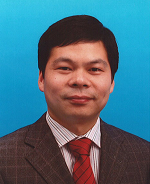Keynote Speaker I

Prof. John Mo
(Fellow of IME and IEA)
Royal Melbourne Institute of Technology, Australia
Biography: John P. T. Mo is Professor of Manufacturing Engineering and former Head of Manufacturing and Materials Engineering at RMIT University, Australia, since 2007. He has been an active researcher in manufacturing and complex systems for over 35 years and worked for educational and scientific institutions in Hong Kong and Australia. From 1996, John was a Project Manager and Research Team Leader with Australia's Commonwealth Scientific and Industrial Research Organisation (CSIRO) for 11 years leading a team of 15 research scientists. John has a broad research interest and has received numerous industrial research grants. A few highlights of the projects include: signal diagnostics for plasma cutting machines, ANZAC ship alliance engineering analysis, optimisation of titanium machining for aerospace industry, critical infrastructure protection modelling and analysis, polycrystalline diamond cutting tools on multi-axes CNC machine, system analysis for support of complex engineering systems John obtained his doctorate from Loughborough University, UK and is a Fellow of Institution of Mechanical Engineers (UK) and Institution of Engineers Australia.

Prof. Zheng Liu
Nanyang Technological University, Singapore
(Fellow of NRF)
Biography: Dr. Zheng Liu received his B.S. degrees (2005) at Nankai University (China), and completed his Ph.D at National Center for Nanoscience and Technology (NCNST), China, under the guidance of Prof. Lianfeng Sun. He then worked in Prof. Pulickel M. Ajayan and Prof. Jun Lou’s groups as a joint postdoc research fellow (2010~2012) and research scientist (2012~2013) at Rice University. Dr. Zheng Liu's research focus on the synthesis, characterizations and applications of novel two-dimensional (2D) crystals, including nitrides (hexagonal boron nitride, h-BN), oxides, transition metal dichalcogenides (TMDs, MoS2, WS2, MoSe2 etc.) He has made great contributions to the 2D materials based nanoelectronics, active nano-systems and high performance energy components, e.g. graphene/h-BN resonators, graphene photodetectors, high-density capacitors, ultrafast lithium storage. He has published more than 50 peer-reviewed papers in top journals such as Nat Mater, Nat Nanotech, Nat Comm, Nano Lett, Adv Mater, JACS, ACS Nano, Small etc. These work have been reported by the impact media such as Science daily, IEEE spectrum etc., and highlighted by the top journals such as Nat Phys, Nat Nanotech, Chem Int Ed, etc. He was a recipient of the 2012 World Technology Award in Energy category. This award has been presented as a way to honor those in doing "the innovative work of the greatest likely long-term significance." He was awarded the Singapore NRF Fellowship in 2013.

Prof. JING Xingjian
The Hong Kong Polytechnic University, Hong Kong
Speech Title: Employing Nonlinear Benefits in Engineering: Human Body Inspired Anti-Vibration structures
Abstract: Nonlinear phenomena are ubiquitous in all engineering systems and in most cases regarded as negative factors to system integration and performance improvement. However, the research advances on nonlinear dynamics nowadays continuously reveal that nonlinear phenomena can bring many amazing and advantageous effects in very practical engineering systems such as vibration control, energy harvesting, structure health monitoring, micro/nano-electro-mechanical systems, and so on. Therefore, employing nonlinearity in engineering applications is a challenging but very promising topic in the literature in recent years. Nonlinearity can be employed in various vibration control, energy harvesting and structure health monitoring for achieving advantageous performance. This talk will focus on a brief introduction of a recently-developed bio-inspired anti-vibration method: human body inspired anti-vibration with nonlinear inertia. It is revealed that human leg is a very beneficial variable stiffness system which can be employed for very advantageous quasi-zero-stiffness design in vibration control, and human arm swing can present an amazing and beneficial nonlinear inertia significantly benefiting vibration suppression or isolation further. Several prototypes and benchmark comparisons are conducted to show the advantages introduced by the novel human body inspired anti-vibration structure. This would provide a cutting-edge vibration control technology to many critical engineering problems with only passive and low-cost structure design.
Biography: Xingjian Jing (M’13, SM’17) received the B.S. degree from Zhejiang University, China, in 1998, the M.S. degree and PhD degree in Robotics from Shenyang Institute of Automation, Chinese Academy of Sciences, in 2001 and 2005 respectively. He achieved the PhD degree in nonlinear systems and signal processing from University of Sheffield, U.K., in 2008. He is now an Associate Professor with the Department of Mechanical Engineering, the Hong Kong Polytechnic University (PolyU). Before joining in PolyU as an Assistant Professor in Nov 2009, he was a Research Fellow with the Institute of Sound and Vibration Research, University of Southampton. His current research interests include: nonlinear dynamics, vibration and control.
